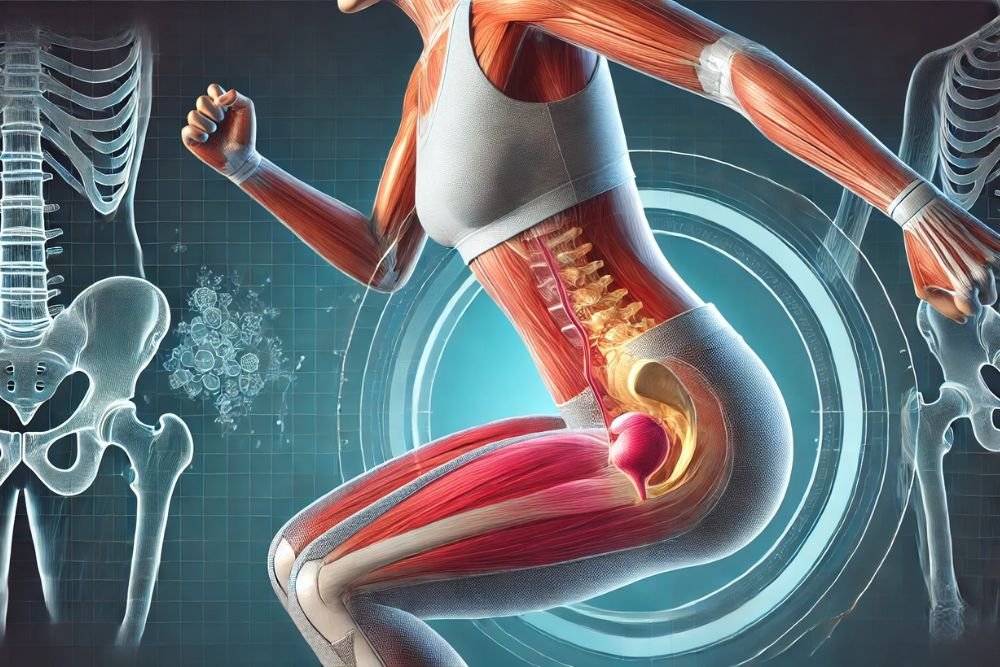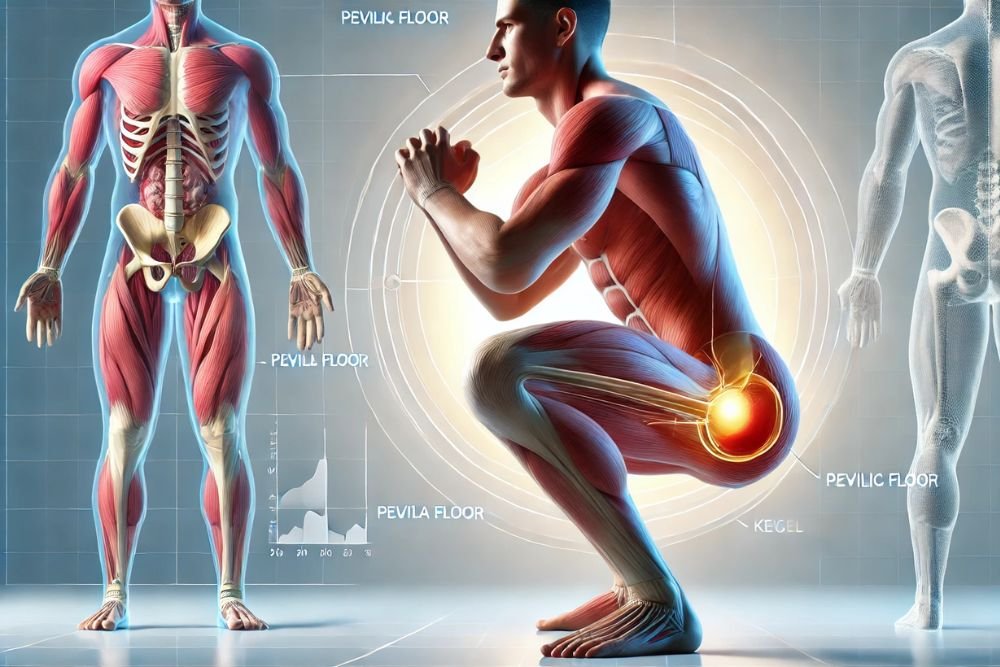Introduction to Kegel Excer
What Are Kegel Excer?
Kegel excer, short for Kegel exercises, are targeted movements designed to strengthen the pelvic floor muscles. These muscles form a critical part of your core, supporting organs like the bladder, bowel, and uterus in women, as well as the bladder and prostate in men. Despite their importance, these muscles often get overlooked until something goes wrong—leaks, discomfort, or even a weakened core.
But don’t worry. Kegel excer can be your saving grace, restoring strength, control, and confidence with consistent practice.
Also read: Kegel Balls | 7 Benefits You Should Know for Pelvic Fitness
Why Focus on Your Pelvic Floor?
Think of your pelvic floor as the foundation of a house. If it’s weak, the structure above becomes unstable. Weak pelvic muscles can lead to issues like urinary incontinence, sexual dysfunction, or lower back pain. Strengthening these muscles with kegel excer helps you reclaim control and prevent these challenges from interfering with your life.
Who Can Benefit from Kegel Excer?
The beauty of kegel excer is their universal appeal:
- Women: Strengthen muscles weakened by childbirth, prevent pelvic organ prolapse, and improve intimacy.
- Men: Recover from prostate surgery, manage incontinence, and enhance sexual health.
- Everyone: Boost core strength, improve posture, and enjoy greater physical and emotional well-being.
5 Effective Routines to Transform Your Health

Routine 1: The Basic Kegel Contraction
This routine is the cornerstone of all kegel excer. Simple but effective, it’s the first step to reclaiming pelvic strength.
- Sit, lie down, or stand in a comfortable position.
- Tighten your pelvic floor muscles as if you’re trying to stop the flow of urine.
- Hold the contraction for 3-5 seconds, then relax for the same amount of time.
- Repeat 10-15 times in a session.
Over time, increase the hold duration to 10 seconds for greater muscle endurance.
Routine 2: Long Holds for Stamina
For those looking to build stamina, this routine is a game-changer:
- Contract your pelvic floor muscles and hold for 10-15 seconds.
- Relax completely for 5 seconds before repeating.
- Perform 8-10 repetitions daily.
This routine strengthens your muscles’ ability to sustain engagement over extended periods.
Routine 3: Pulsing Contractions for Responsiveness
This routine mimics real-life scenarios where quick muscle engagement is essential:
- Quickly tighten and release your pelvic floor muscles in rapid bursts.
- Complete 20-30 pulses in a session.
- Rest for a minute and repeat up to three times.
This exercise enhances your muscles’ ability to react swiftly, reducing leaks or accidents during sudden movements.
Routine 4: Combining Kegels with Functional Movements
To make kegel excer even more impactful, combine them with everyday movements. This routine strengthens your pelvic floor while engaging other parts of your body:
- Bridge Pose: Lie on your back with your knees bent and feet flat on the ground. As you lift your hips, tighten your pelvic floor muscles. Hold for 5-10 seconds, then relax as you lower your hips.
- Plank Kegels: While holding a forearm or full plank, engage your pelvic floor muscles for 5 seconds, then release. Repeat this for 10-12 reps.
- Walking Contractions: While walking, tighten your pelvic floor muscles for 3-5 seconds with each step, then relax.
These functional movements integrate kegel excer into your routine and train your muscles for real-life scenarios.
Routine 5: Advanced Kegels with Resistance
For those ready to level up, adding resistance to your kegel excer can significantly boost results:
- Weighted Kegels: Use Kegel weights to add intensity. Insert the weight and hold it in place by tightening your pelvic floor muscles. Gradually increase the weight as your strength improves.
- Resistance Bands: During squats or lunges, place a resistance band around your thighs. Engage your pelvic floor at the lowest point of each movement.
- Dynamic Resistance: Apply gentle internal or external pressure to challenge your muscles further during contractions.
These advanced techniques amplify strength and endurance, ensuring continued progress.
Why Consistency Matters
Consistency is the secret sauce to seeing results with kegel excer. Here’s why sticking to your routine matters:
- Stronger Muscles: Regular practice ensures steady improvement.
- Better Control: Over time, you’ll notice fewer leaks, better bladder control, and improved stamina.
- Long-Term Benefits: Strengthening your pelvic floor now prevents age-related issues later.
The Science of Kegel Excer: How It Works
What Happens When You Practice?
When you engage in kegel excer, you’re targeting the group of muscles that form a supportive sling at the base of your pelvis. With regular contractions and relaxations, these muscles grow stronger, just like any other muscle in your body.
Proven Benefits Backed by Research
Research consistently highlights the benefits of kegel excer:
- Improved Bladder Control: Studies show that consistent practice reduces urinary incontinence in both men and women.
- Enhanced Sexual Health: Stronger pelvic muscles lead to increased sensation and satisfaction during intimacy.
- Support During Recovery: For those recovering from childbirth or surgery, Kegels accelerate healing and restore strength.
Real-Life Success Stories
Emma’s Journey: A new mom shares how kegel excer helped her regain confidence and control post-pregnancy.
John’s Recovery: After prostate surgery, John credits resistance-based Kegels with helping him rebuild strength and control.
Sophia’s Transformation: As a fitness enthusiast, Sophia integrated advanced Kegels into her yoga routine, improving her core strength and balance.
Enhancing Your Kegel Excer Routine
Overcoming Common Challenges
Even with the best intentions, practicing kegel excer consistently can present a few hurdles. Here’s how to tackle them:
“I Can’t Find the Right Muscles”
This is a common challenge for beginners. To locate your pelvic floor muscles:
- Imagine stopping the flow of urine midstream (but don’t do this frequently as it can cause issues).
- For men, think of lifting your testicles. For women, visualize tightening around a tampon.
Once you’ve identified the muscles, focus on isolating them without engaging your abs, glutes, or thighs.
“I Keep Forgetting to Practice”
Building any new habit takes time. Here’s how to stay on track:
- Set Reminders: Use alarms or habit-tracking apps to prompt daily sessions.
- Pair With Habits: Combine Kegels with daily routines like brushing your teeth or waiting for coffee to brew.
- Track Progress: Keep a journal of your sessions to stay motivated and accountable.
“I Don’t See Results Yet”
Results take time, so don’t get discouraged. Most people notice improvements in 4-6 weeks of consistent practice. Remember:
- Small gains, like holding contractions longer or fewer leaks, indicate progress.
- Adjust your routine by increasing intensity or trying new techniques as your strength improves.
Staying Consistent With Kegel Excer
Consistency is the foundation of any successful fitness routine, including kegel excer. Here are some tips to maintain your practice:
- Create a Routine: Dedicate specific times each day for Kegels, such as morning, midday, and evening.
- Set Achievable Goals: Start with a few minutes daily and gradually increase duration and intensity.
- Celebrate Successes: Acknowledge milestones, like completing more reps or improving bladder control.
Beyond Basics: Advanced Kegel Excer Techniques
Reverse Kegels for Flexibility
While traditional Kegels focus on contraction, reverse Kegels emphasize relaxation:
- Focus on gently pushing outward, as if starting to urinate or release gas.
- Hold the relaxed state for 5-10 seconds, then return to neutral.
- Repeat 8-10 times to balance strength with flexibility.
Reverse Kegels are particularly helpful for those with tight pelvic muscles or discomfort.
Combining Kegels With Core Workouts
Integrating kegel excer into other exercises amplifies results:
- Dead Bugs: While performing this core exercise, engage your pelvic floor during leg and arm movements.
- Pilates: Incorporate Kegels into movements like the hundred or roll-ups.
- Plank Variations: Activate your pelvic muscles during forearm or side planks.
Biofeedback Devices for Precision
For those seeking to perfect their technique, biofeedback tools are invaluable:
- Provide real-time feedback on muscle engagement.
- Help ensure proper technique and measure progress.
- Motivate consistent practice by visualizing improvements.
The Bigger Picture: Why Kegel Excer Matters

Supporting Overall Health
The pelvic floor doesn’t just support bladder and bowel control—it’s central to your core stability and movement. Strengthening these muscles improves posture, reduces lower back pain, and enhances athletic performance.
Boosting Confidence and Quality of Life
Feeling in control of your body fosters confidence. Whether it’s fewer bathroom trips or improved intimacy, kegel excer can make a profound difference in your daily life.
Achieving Long-Term Success with Kegel Excer
Making Kegel Excer a Lifelong Habit
Success with kegel excer isn’t just about mastering the technique—it’s about consistency. Here’s how to build a sustainable routine:
Incorporate Kegels Into Your Daily Life
- While Commuting: Practice contractions while sitting on the bus or driving.
- At Work: Tighten your pelvic floor muscles during meetings or while at your desk.
- Before Bed: Use Kegels as a calming wind-down exercise before sleep.
By tying Kegels to daily activities, they become a seamless part of your routine.
Adjust Your Goals Over Time
As your muscles strengthen, your routine should evolve:
- Increase Hold Times: Gradually extend from 5 to 10 seconds or longer.
- Add Reps and Sets: Aim for 3-4 sets of 15-20 contractions daily.
- Incorporate Resistance: Use tools like Kegel weights or resistance bands for advanced strength-building.
The Long-Term Benefits of Kegel Excer
Preventing Future Issues
A consistent Kegel routine helps prevent:
- Urinary incontinence as you age.
- Pelvic organ prolapse, especially in women.
- Chronic pelvic pain caused by muscle weakness.
Enhancing Athletic Performance
For athletes, a strong pelvic floor improves:
- Balance and core stability.
- Stamina and control during physical activities.
- Recovery from intense training or injuries.
Boosting Emotional Well-Being
Improved pelvic health often leads to:
- Greater confidence in social and personal interactions.
- Reduced anxiety about bladder control or intimacy.
- A more active and enjoyable lifestyle.
Addressing Challenges Over Time
Overcoming Plateaus
If progress slows:
- Introduce advanced techniques like reverse Kegels or pulsing contractions.
- Add resistance tools or biofeedback devices for greater intensity.
- Seek guidance from a physical therapist for personalized advice.
Maintaining Motivation
Staying committed is easier when you:
- Celebrate milestones, like holding contractions longer or reducing leaks.
- Join online communities to share experiences and gain support.
- Focus on the broader benefits, like improved quality of life and confidence.
Conclusion: Transform Your Health With Kegel Excer
Kegel excer are more than exercises—they’re a gateway to better health, confidence, and control. Whether you’re a beginner or looking to advance your practice, these routines and tips provide a roadmap to lifelong pelvic health.
Take the First Step Today
Don’t wait to experience the transformative benefits of kegel excer. Start incorporating these exercises into your daily life and discover the difference they can make. Have questions or success stories to share? Leave a comment below and join the conversation about building a stronger, healthier you.